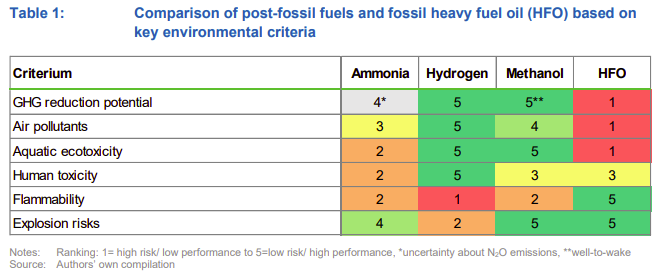A new NABU study found ammonia has a high potential as a green shipping fuel, provided that nitrous oxide generated during the combustion is eliminated, that harmful nitrogen oxide emissions are addressed, and that strict safety regulations are ensured to prevent leakage.
Amid a growing discussion on the potential of ammonia as a marine fuel along with other options, German environmental protection organization NABU charged the German Öko-Institut to investigate the extent to which ammonia can play a role as a green fuel of the future, ensuring at the same time that it is safe for humans and the environment.
The key finding of the study is that the maritime sector will likely rely on different post-fossil fuels in the future depending on the market segment. If ammonia is to contribute to short-term emissions reductions in shipping, the pace of engine development and subsequent deployment needs to increase.
Ammonia as a marine fuel can only fully develop its climate protection potential if the harmful emissions of nitrous oxide that arise in production, transport and combustion are almost completely eliminated. To ensure this, all kinds of greenhouse gases must be included in national and international regulations on GHG reduction and pricing,
…said Beate Klünder, NABU shipping expert.
According to the study, the acute ecotoxicity to aquatic organisms of ammonia is comparable to HFO. In the long term, spills of ammonia seem to be of lesser concern than for HFO because ammonia concentrations would decrease fast.
 [smlsubform prepend=”GET THE SAFETY4SEA IN YOUR INBOX!” showname=false emailtxt=”” emailholder=”Enter your email address” showsubmit=true submittxt=”Submit” jsthanks=false thankyou=”Thank you for subscribing to our mailing list”]
[smlsubform prepend=”GET THE SAFETY4SEA IN YOUR INBOX!” showname=false emailtxt=”” emailholder=”Enter your email address” showsubmit=true submittxt=”Submit” jsthanks=false thankyou=”Thank you for subscribing to our mailing list”]
In addition, ammonia is a carbon-free energy carrier, but combustion emissions could be harmful to the environment if they remain unaddressed. NOx emissions can be eliminated via common exhaust gas after treatments like SCR. Future engine tests will need to minimize ammonia slip through engine optimization andany remaining ammonia slip might also be addressed via exhaust gas after treatments.
Meanwhile, N2O emissions from ammonia combustion are a major concern due to the high GWP of N2O. As such, stringent N2O emission regulations need to be established to ensure that ammonia engines are compatible with the long-term goal of decarbonizing maritime shipping. N2O could be integrated, therefore, in carbon pricing policies or limited through emissions standards.
Further research is necessary to clarify the quantity and type of emissions resulting from burning ammonia in varying ratios with other fuels and to develop appropriate abatement technologies.
The study also finds that even if ammonia is not widely used as a fuel in shipping, investments in ammonia infrastructure will not be stranded assets, as ammonia will play an important role in the decarbonization of other sectors in the hydrogen economy. The timely financial and legal promotion of green ammonia production under the necessary environmental and safety requirements would therefore be a no-regret decision for climate protection in contrast to today’s decisions for LNG use and infrastructure.
In the short term, supply of green ammonia will be limited. Green ammonia production would need to increase considerably in order to supply even a small amount of the maritime sector. This is, however, true for all post-fossil fuels. There are potential synergies with the decarbonization of other sectors which will also need green ammonia, like agriculture.
Robust certification systems for green ammonia will have to be developed as soon as possible.
To address the risks of ammonia, amendments to the IGF and IGC code are required to:
- enable its use a fuel in shipping (and not only as a cargo),
- account for a safe handling of ammonia on-board,
- introduce standards and protocols in the case of accidents or leakages to the environment.
In search of the green future fuel, we should not lose sight of harmful air pollutant emissions. In order to reduce harmful nitrogen oxide emissions resulting from the combustion of ammonia but also of most fossil fuels used today we need a strict global exhaust gas regulation. In addition to regulating greenhouse gases, the IMO has to ensure that a global nitrogen oxide control area is immediately set up to pave the way for completely zero-emission shipping,
…requests Klünder.
Such a regulation could be initiated immediately at the IMO, since this is an approved measure that is already taking effect in the North and Baltic Sea and the North American waters, NABU noted.
In line with the precautionary principle and to provide incentives for the new technologies to avoid all GHG emissions, the environmental integrity needs to be ensured by means of stringent regulation which cover all greenhouse gases and particularly include N2O,
…the study concludes.




























































